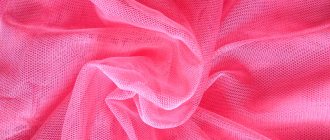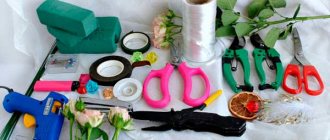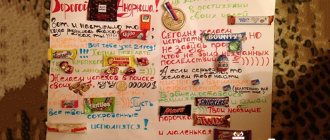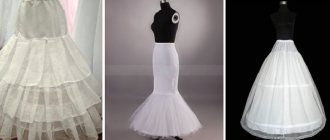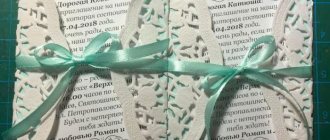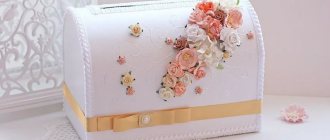Types of petticoats for wedding dresses
Types of petticoats for wedding dresses
In the minds of most, the distinctive feature of a wedding dress is a fluffy airy skirt, which emphasizes the specialness of this day for the bride. This effect is provided to the skirt by a special frame - a petticoat. A wedding petticoat is worn under the dress, giving the lower part additional volume and creating the necessary support.
In wedding dresses with ruffles, petticoats allow the frills to lie beautifully. In smooth dresses without additional ruffles, the crinoline lifts the bottom of the skirt, also giving the dress a formal look. Thus, a petticoat is a necessary element of a wedding dress, adding a sense of completeness to the image. Moreover, the crinoline also has a functional task - to raise the long hem of the dress so that the bride does not catch it with her heels and tear it.
There is an idea that these dress elements are only necessary for fluffy wedding dresses in the ballroom style or a la “princess” style. This is not true at all. There are many different types and styles of crinoline, suitable for different models of wedding dress. They are able to give the skirt both impressive volume and simply allow it to lie beautifully.
In addition to the fact that the crinoline should form the bottom of the dress, it should be comfortable for movement and dancing, quite light for the bride and invisible to prying eyes. Wearing it at a celebration for more than one hour.
It is noteworthy that professional seamstresses practically do not use the term “petticoat”. For them, this part of women's clothing is called a “frame”, “petticoat” or “cover”.
Crinoline on rigid rings
One of the most popular and budget models.
When the petticoat first appeared, it was sewn from a special material consisting of linen threads and patches of horsehair. This gave the fabric the necessary rigidity, due to which the desired shape was perfectly maintained.
Today, a special mesh with rigid rings is used for these purposes. Depending on the style, the number of rings in a crinoline can vary from one to seven.
A petticoat with rings allows the bride to move freely without the risk of her heels catching the hem. At the same time, the model also has obvious disadvantages. Firstly, due to the rigidity of the frame, the petticoat does not fold well when its wearer gets into a car or climbs stairs. Secondly, rigid rings tend to show through the thin fabric of a wedding dress - this is especially noticeable when moving. Therefore, this style of crinoline should be chosen only for dresses made from dense and heavy fabric.
Simple
It’s impossible to come up with a simpler design than the Tatyanka petticoat. Here you don’t need any special skills to sew it yourself.
First you need to take measurements. This is the circumference of the hips and the length of the petticoat.
To find out the waist width, multiply the hip circumference by the fit factor. Its value is in the range of 1.5-3.5 times. Here it’s up to you to decide how full the skirt will be. The main thing to take into account is that the stiffer the fabric, the lower the coefficient will be.
The length is measured from the waist or where the petticoat will be located to the desired length. However, it should be shorter than the dress.
Now we take a rectangular piece of fabric according to the measurements. You can take any lining fabric that holds its shape well. It is advisable to steam it first so that when washing the finished product there is no shrinkage. Cotton fabric is lined. You can also take mesh (tulle), but in this case the volume at the waist will be large.
Finish the side edges with a double seam or an overlock stitch. Then grind them down. Finish the top and bottom edges with a closed hem stitch. At the same time, leave room in the upper cut for stretching the elastic. The bottom hem should be wider so that the bottom of the skirt holds its shape better. And for rigidity, you can insert a fishing line or crossbar.
Be sure to steam all seams thoroughly. After threading the elastic, sew its ends together into a ring.
A master class on sewing a simple petticoat is in the video below.
Source
Crinoline with soft rings
This type of crinoline has its obvious advantages over crinoline with rigid rings. It has a lighter and softer design; the rings are made of plastic rather than metal. Also, when creating it, a fabric base is used, not a mesh one.
The advantage of this type of crinoline is that the soft rings of the petticoat do not stand out when moving. Thanks to their softness and flexibility, it is also easy to walk and dance in, and there are no problems when getting into a car or climbing stairs. Petticoats can be worn even under very thin and transparent fabrics such as chiffon, organza or lace.
At the same time, one cannot fail to note the disadvantages. Due to the fragility and fragility of the plastic used, crinoline rings often crack and break when pressed or mishandled. If this happens during the celebration, the outfit may be ruined. Also, the cost of such petticoats is higher than that of crinoline with rigid rings.
The number of rings determines what type of wedding dresses it can be used for. If there are only a few rings (one or two), then it will look great with empire wedding styles or straight-cut dresses to give them a little volume. If there are a lot of rings - from three to five - then the frame is good for ball gowns, princess models, as well as A-line. For mermaid style options, there are special crinolines with one ring at the bottom.
Edge processing
An important step when sewing a petticoat is finishing the edge. It is necessary for the product to look decent in case the dress accidentally rises. Some clothing models are designed so that the petticoat deliberately protrudes beyond the hem - they are made from a material in a contrasting color and are not subjected to any processing. In this case, all edges must be carefully trimmed to avoid unevenness.
If the bottom edge of the petticoat needs to be decorated beautifully, this can be done in three ways:
- a seam with a closed or open cut - for this you need to fold the fabric once or twice and apply a simple machine stitch to secure it;
- using decorative tape - if the edges of the tape look sloppy, they must first be folded and hemmed, and only then decorate the bottom of the petticoat with them;
- lace decor - they are sold ready-made, with finished edges, so they just need to be sewn onto a pre-hemmed edge of the hem.
In addition, you can use special wire. It is attached to the edge of the petticoat using a ribbon and beautiful waves are created with your hands. This option is very often used in children's dresses or fancy dress costumes. If petticoats have several layers, these wavy edges make the hem much fuller. The wire can be hidden under tape of different colors, different from the material itself.
To prevent the side seams from clinging to the tights or rubbing the skin, they must be laid from the outside.
Products made from tulle are airy, but at the same time keep their shape well. Making a petticoat with your own hands is quite easy, since the process does not require skill or experience. In this case, you can save money and in just an hour create a wardrobe item that will last for many years.
Multilayer crinolines without rings
There are also models of crinolines that do not have rings at their base. Volume is achieved through the use of layers of fabric firmly sewn on top of each other.
Despite the apparent success of the idea of the absence of rings that show unattractively through the delicate fabric of a wedding dress, a petticoat without rings has its drawbacks. Firstly, creating such a frame requires a very large amount of material, which significantly increases the cost of the product. Secondly, such a percentage of synthetic material, from which such petticoats are most often sewn, provides poor ventilation. As a result, this option is not the most suitable for a wedding on hot summer days. Also, according to brides who used a similar frame, walking in it is not very comfortable.
The option of a multi-layer petticoat is suitable only for short dresses - mini or knee-length.
As a separate option for a multi-layer crinoline, you can highlight a colored petticoat. It is specially made longer than the main dress so that the colored frame can be seen when moving. This crinoline performs a double role - a frame for the skirt of a wedding dress and a non-standard decorative element.
How to decorate a petticoat for a girl
To make the petticoat sparkle, you can decorate it in an original way so that no one else has it. In this matter you need to give free rein to your imagination. For example, the edge of a skirt can be sewn with a beautiful satin ribbon.
You can sew small flowers made of fabric or leather onto the petticoat. You can also decorate with beads, feathers, rhinestones, and beads. A fluffy light skirt with the addition of natural fur will look luxurious. If a girl plays the role of a princess or Snow Maiden, then tinsel can be sewn along the edge. If you are preparing a ladybug costume, then circles made of dark velvet will look beautiful on the petticoat, and the skirt itself can be red.
Note! The main thing is to discuss the decoration of the skirt with your child, listen to his preferences and decorate the product together.
Young girls prefer to wear tutu skirts. You can also use this material to sew identical dresses for bridesmaids for a wedding.
This fabric requires careful care. Here are some tips:
A tulle petticoat will look elegant and light. It can be worn in the summer in everyday life, combined with different elements of clothing, for a holiday, decorated with different colors, etc. The price of tulle is low compared to other fabrics (from 80 rubles * per 1 m). Moreover, thanks to this article, you can save some money and sew the product yourself. It's easy and simple.
*Prices are as of June 2022.
Source
Crinoline for models with a train
The petticoat for a dress with a train is the most difficult to find, which is why such models are the most expensive. Most often, they are completely made to order. They are sewn like models with rings, but special frills are made on top of them. The crinoline is also extended by the size of the train.
A significant drawback is its inconvenience. When moving and trying to sit down, the train lies in one direction, while the mesh frills lie in the opposite direction. This makes the process of wedding video and photography difficult.
Measurements and calculations
Before sewing a petticoat, you need to take some measurements. First of all, the waist circumference and length of the future product are determined. According to the standard, the lower part should not be visible from under the hem, so it is approximately 2/3 of the length of the skirt. However, modern fashion allows the bottom of the petticoat to be exposed, so in many models it is specially decorated.
For a reasonable consumption of fabric for a petticoat, a special formula for the gathering coefficient (Ksb) is provided, which will help calculate the length of the tulle strip. It looks like this: Ksb = Ds/Dk, where Dk is the length of the upper edge of the canvas, which should be obtained after assembly (most often it is equal to the waist volume), and Ds is the length of the lower edge.
As an example, you can substitute real values into the formula, Dk = 70 cm, and Ds = 155 cm, then Ksb = 155/70 = 2.2. Knowing this coefficient, you can quickly calculate how much material should be used to sew models with different parameters. For example, if you need to make a similar petticoat, but of a different size, you can calculate how long the fabric will be needed for sewing. To do this, you need to multiply the waist circumference by the resulting coefficient, for example, 86 cm × 2.2 = 189 cm.
The number of layers depends on the desired volume of the finished product. Thus, hard tulle holds its shape well - often one layer is enough. When working with soft fabric, it is advisable to make several tiers.
Required measurements
Crinoline with frills made of mesh or fabric (gest)
Underskirt models made of mesh fabric or tulle with numerous frills are called jest. Numerous frills are sewn to the frame to create the required length and volume. Worn either as a stand-alone petticoat or over a crinoline with rings. In the latter case, this will allow you to close the petticoat rings from showing through, and will also provide additional volume. If the gesture model comes as an independent element, then, unfortunately, it will not be able to provide a good volume.
Sun skirt with asymmetrical hem
How to model such a skirt
Vertically, starting from the bottom, we measure sequentially:
- minimum length of DI mini;
- two radii R = 1/3 St + 1 cm;
- maximum length of DI max.
Usually the minimum length is taken to be 40 cm, the maximum - 90 cm.
Next, we’ll figure out how to calculate the length along the transverse and oblique threads of the panel.
Along the transverse thread, the length will be equal to half the sum of the minimum and maximum lengths. For example, (40 + 90) : 2 = 65 cm.
The length along the oblique mini is equal to half the sum of the DI mini and transverse.
(40 + 65) : 2 = 52.5 cm.
The length along the oblique maxi is equal to half the sum of the DI maxi and transverse.
(90 + 65) : 2 = 77.5 cm.
We mark the calculated values and connect the ends of the segments with a smooth curve.
We cut out the part and sew the skirt. For the fastener, we make a cut in the back for the length of the zipper plus 5 - 7 cm.
If the width of the fabric does not allow the product to be made without seams, then the skirt pattern must be cut into two parts (see picture).
The layout on the fabric will also be different.
Choosing fabric for a petticoat
The petticoat is made from one type of material or from a combination of fabrics. It depends on the purpose and design features of the product. For a classic petticoat, as well as for a voluminous base (or yoke), take natural fabric (cotton, silk) of sufficient density. Viscose, organza, chiffon, satin, and lining fabric are also suitable.
The layers and frills of a voluminous petticoat are sewn from different types of tulle (soft, medium and high hardness) or taffeta. Rings for it are made from synthetic tape - regilina.
Ten stylish tips for choosing a wedding dress style
The choice of style directly depends on the proportions (height and figure). Below we give a few tips that should not be neglected if you want to sew a wedding dress with your own hands.
For girls of small stature, a modest, floor-length outfit is best suited. In combination with a high heel, it elongates the figure. It is better for plus-size women to avoid outfits with voluminous skirts; in such a situation, a straight dress would be optimal. For ladies with curvy hips, we advise you to take a closer look at dresses with a round neckline, open shoulders and a lace top - this way you will shift the emphasis from the hips to the chest and neck. Tall height will be hidden (if, of course, you want to hide it) by a dress with a full skirt. Lush breasts look neater in a dress with a high neckline
It would also suit a lady with a swan neck;) Grecian-style wedding dresses and bustier dresses look great on figures with a small bust. For the lucky owners of an hourglass figure, any model will suit you, but we recommend paying attention to the “mermaid” or “fish” - your waist in such an outfit will be even thinner! Apple-shaped figures will also suit an outfit with a high waistline. If you can boast of slender legs, pay attention to short wedding dresses. For girls with a beautiful shoulder line, we recommend thinking about a dress with straps that are slightly lowered on the forearms.
Constructing a pattern
Has your wedding dress pattern been chosen? Then you can safely transfer it to tracing paper using carbon paper and cut out the pattern in full size.
If your search for a pattern to sew a wedding dress has not been successful, you can try to build it yourself using individual measurements. The finished pattern can be found in magazines (we recommend checking out Burda issues), purchased in fabric stores or found on the Internet.
Important! Be sure to check the purchased or downloaded pattern with your measurements and, if necessary, adjust it!
Work on a drawing, as a rule, begins with the construction of a basic mesh. Having completed the appropriate calculations, we draw the points, connect them with segments, form the neckline, darts, waistline, shoulder bevel and adjust the length of the product. Sewing a wedding dress with your own hands using your own pattern will be within the capabilities of experienced craftswomen, but we recommend that beginners use ready-made patterns.
